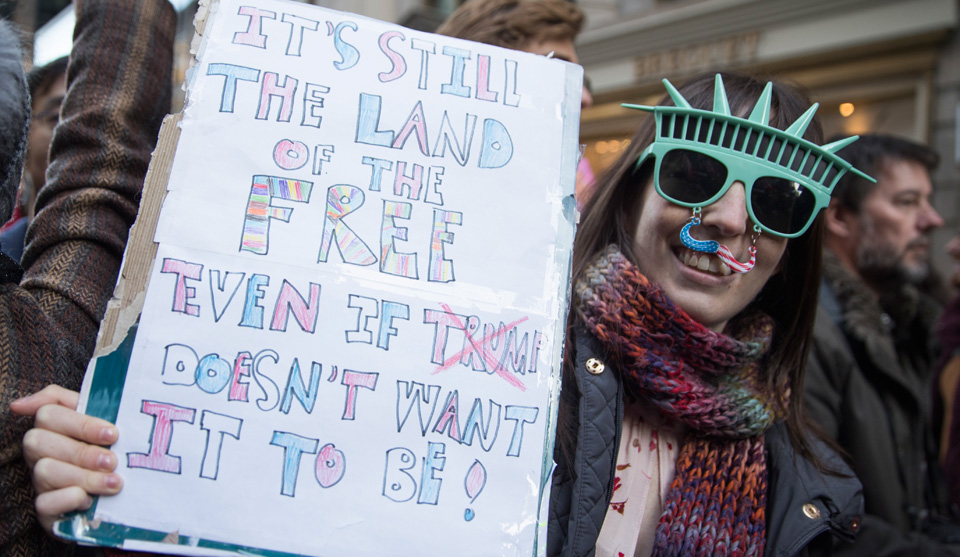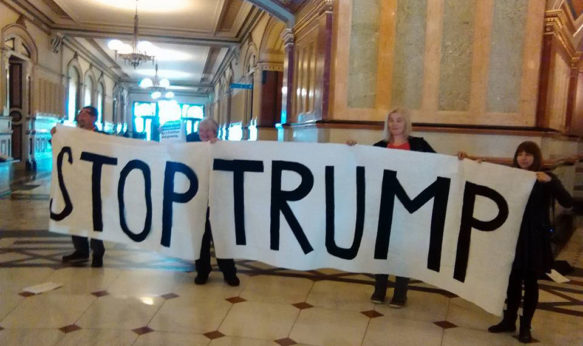
In this, the last of three articles he has written on the election, People’s World contributor Marc Brodine takes a page from the anti-fascist struggles of the past and examines what’s needed to build a broad, united resistance in our own time. Read Part 1. Read Part 2.
During the long primary and election campaigns of 2016, it became clear that few if any of the old political rules apply anymore. We need to take a long and detailed look at the 2016 elections in order to develop the best strategy to resist the unconstitutional attacks that Trump is already proclaiming. We need to build coalitions and movements, both short-term on specific issues and long-term on wide-ranging fronts. We also need to learn from history, including from the anti-fascist struggles of the last century. This is the last in a three-part series taking a look at some of these issues.
Breadth or militancy?
Both coalition breadth and militancy have to be part of our judging process. Anything else leads us in wrong directions. Using only militancy as the measure, we end up refusing to “tactic shame” the anarchists who bust windows as a way of expressing their anger, turning off many potential allies, wasting efforts and resources on dead-end actions and dead-end legal wrangles over side issues. Using only breadth as the measure, we water down programmatic demands till they are almost meaningless in the pursuit of an elusive broad coalition – arguably one of the problems in the stance of the Clinton campaign’s focus on Trump’s lack of character.
Real breadth and militancy go hand-in-hand. Militant actions around specific issues, such as the Dakota Access Pipe Line struggle, inspire millions to join in and express solidarity. Broad unity built on opposition to Trumps’ Cabinet and appointments shows the power of a broad united opposition.
While we need to build the broadest opposition, we should not have illusions about institutional obstacles to Trump’s policies. While we should certainly call for and struggle for full democracy and constitutional rights, just having a constitution and civil rights is no ultimate protection – see the example of Chile in the 1970s. That country had a long tradition of constitutional protections, restrictions on the military’s role in politics, and of peaceful transfer of power to newly-elected representatives. That all went out the window when General Pinochet overthrew President Allende.
Part of our struggle has to include calls for Trump and his minions to respect constitutional rights and political norms, but we can’t count on it. Already, Trump allies are calling for anti-Trump demonstrations to be outlawed, for criticism of Trump to be muffled, for demonstrators to be “quelled.”
Calls to maintain our democratic traditions, even though those traditions have always been more limited in reality than in our high school history books, are part of the most broadly-unifying efforts right now. Many Trump supporters expect that he will not represent a break with the Constitution, and to the degree that we show him to be unconstrained by such considerations, to that same degree we can win or neutralize this group.
To take one small example, Trump, Pence, and their surrogates proclaimed throughout the campaign that Trump would eventually release his tax returns. One small part of our efforts should be to hold them to that promise. He said it, Pence said it, it is on tape; we should demand that he keep his word. By itself this is but a minor sideshow, but it is one part of exposing his lies.
Part of the fight for democracy is the fight for truth, for facts. Exposing Trump and some of his supporters as outside the normal constraints of U.S. politics is part of winning a coalition broad and powerful enough to defeat his policies and the normalizing of racism, xenophobia and misogyny. Condemning the growing anti-Semitism is also a piece of this.
There is a fine line to walk; we must challenge Trump’s distortions but still avoid getting caught in his trap of an endless loop of refuting each and every tweet, keeping the focus on whatever outrageous thing he says. Our refutation of his lies needs to be more substantive, based on his whole program or major aspects of his policies, rather than falling for his bait.
Another fault line in Trump’s coalition is between the more “standard” Republicans who want to use the system to their advantage, and the ultra-right fascists who are acting out on our streets, inflicting violence on innocent people, painting swastikas on churches, and sending terror threats to mosques. Supposedly “mainstream” Republicans need to be held accountable for the actions of the ultra-right that they have loosed on the nation.
Increases in corruption and incompetence will also open the door to broadening anti-Trump alliances. Already the conflicts of interest, the self-serving use of governmental office to line the pockets of the President-elect, his family, and cronies are self-evident. Some center and even conservative voices will be horrified at the levels of corruption, past and present.
The race for democracy
We must put the fight for democracy at the center of our unity-building efforts. We are in a race – a race between those coalition efforts and the efforts of the Trump circle to change the political rules of the game to guarantee their continued ascendance. We can predict a wave of rejection and revulsion against his anti-democratic policies, but will that happen quickly enough to defeat them? We are moving toward a tipping point – either we tip toward fascism or we tip toward the left to a program that addresses the real needs of our class and people with real solutions.
We can already predict that Trump will do as he has promised: work to damage democracy civil rights, women’s rights, union rights, and the environment. He and his allies will use this shift of political power and initiative to attempt to fulfill their fantasies of eliminating abortion rights, eliminating unions, eliminating or at least depressing voting rights, abolishing immigrant rights, privatizing Medicare and Social Security, and many more anti-people policies. Other battles loom over privatizing education and incarceration, climate policy, over militarizing even more of U.S. foreign policy. The list keeps growing.
Defeating Trumpism means fighting every effort to weaken democracy. As Georgi Dimitrov noted [see part 2 of this article for more on Dimitrov], “before the establishment of a fascist dictatorship, bourgeois governments usually pass through a number of preliminary stages and adopt a number of reactionary measures which directly facilitate the accession to power of fascism. Whoever does not fight the reactionary measures of the bourgeoisie and the growth of fascism at these preparatory stages is not in a position to prevent the victory of fascism, but, on the contrary, facilitates that victory.”
Trump’s election is not the triumph of fascism, but it does give neo-fascists the political power to chip away at and attack the very basis of U.S. democracy. Dimitrov pointed out:
“The accession to power of fascism is not an ordinary succession of one bourgeois government by another, but a substitution of one state form of class domination of the bourgeoisie – bourgeois democracy – by another form – open terrorist dictatorship. It would be a serious mistake to ignore this distinction, a mistake liable to prevent the revolutionary proletariat from mobilizing the widest strata of the working people of town and country for the struggle against the menace of the seizure of power by the fascists, and from taking advantage of the contradictions which exist in the camp of the bourgeoisie itself.”
He continued, saying:
“But it is a mistake, no less serious and dangerous, to underrate the importance, for the establishment of fascist dictatorship, of the reactionary measures of the bourgeoisie at present increasingly developing in bourgeois-democratic countries – measures which suppress the democratic liberties of the working people, falsify and curtail the rights of parliament, and intensify the repression of the revolutionary movement.”
Republican efforts to chip away at democratic rights have been going on for quite some time. The attacks on the democratic right to vote has been fierce and multi-pronged, although varying in detail from state to state. They include voter ID requirements, rules making it more difficult to register, cutting or eliminating early voting days, gerrymandering, closing polling places, purging voter rolls without proof, stopping efforts to automatically register voters, threatening various voter intimidation tactics, and promoting the role of big money in politics.
These are all part of Republican efforts to restrict the ballot, to make it difficult for students, minorities, and poor people to vote, to prevent felons from regaining their right to vote, to limit the franchise in as many ways as possible and resist the demographic trends that are turning against the right.
One of the limitations of U.S. democracy was put on display as the Electoral College played a bigger role in determining who won the election than did the popular vote. The Electoral College itself is an undemocratic hangover of our past, a compromise with slaveholders that more populous Northern states wouldn’t control the Federal Government at the expense of the slaveholders. Its elimination is one piece of the fight for full democracy.
Another piece is reversing the Citizen’s United Supreme Court ruling that allowed unlimited money in politics. Money is not speech, and billionaires contributing massive sums behind the scenes with no public accountability is not the same as political freedom. Billionaires are as free as anyone else to vote for whomever they want, but that does not give them the right to buy politicians or elections.
But the fight to reverse the anti-democratic attacks lies not just in electoral reform or legal fights to protect the right to vote. It also lies in fighting for union rights – for the right to strike, the right of unions to participate in the electoral process, to represent their members, and to fight for the needs of all. Missouri just passed so-called “Right-to-Work” legislation, and there will be Republican efforts to get a similar law passed nationally.
The fight for democracy is not a side-show, a tangent separate from “real” resistance to Trump and his ultra-right allies. It is the broadest possible field for drawing on the democratic traditions and expectations that permeate our culture. It is the fight to win the broadest possible rejection of his policies, to convince even some conservatives to stop implicitly supporting some or all of Trump’s program.

Building layers of coalitions
In practical terms, there will not be one, united, massive anti-Trump coalition, brought together into a single organizational form. We might think of it as layers of coalitions, a combination of permanent and temporary alliances. The people’s movements need a deeper understanding of and approach to building coalitions.
Coalitions can be groupings made up of people and organizations that disagree with each other – otherwise, they would already be in the same organization! Such temporary or partial coalitions come together around one issue or one set of issues where they have common agreement, and their focus must of necessity be on those areas of agreement. Successfully growing unity depends in part on acknowledging and respecting those differences, not pushing them away but taking them into account. Coalitions increase the strength of struggles, but they also have built-in limitations we cannot afford to ignore.
Coalitions can also be long-lasting alliances between organizations which share many common values and goals – in some senses all major movements are coalitions of this type. The labor movement itself brings together workers from many different backgrounds, points of view, and political opinions. Alliances between unions, religious groups, and other community organizations have a different character than single-issue coalitions. Broad progressive alliances for democracy, civil rights of all kinds, are already in existence and planning resistance.
Building unity and analyzing the reasons for Trump‘s success is not the same as settling old scores or assigning blame, as too many are attempting to do. There are many battles to wage, many ways to unite. We can’t reduce the broad movement we need to some abstract notion of political purity.
We can “unite” with Lindsey Graham’s call to investigate the role of Russian hacking in the election without uniting with his support for most aspects of the Republican program. We can support his bill to protect the Dreamers. Over 750,000 are terrified that Trump, with the stroke of his pen, will place them in immediate jeopardy of deportation from the country they have grown up in. Agreeing with Graham on this one issue would be a temporary, partial unity, not a unity that we could expect to show up across the board, maybe not anywhere else. But for one short political moment, we can agree to join together.
It doesn’t mean agreeing with the anti-Russian fulminations of some Democratic leadership circles, it just means that exposing Trump’s ties abroad and the efforts of the Russian oligarchy to influence the U.S. election will help expose Trump’s lies and obfuscation. Exposing his business conflicts-of-interest is another piece of exposing and defeating his whole program, cutting away at his claims of honesty and legitimacy.
A winning strategy
What kind of strategy does the broad movement need? In the post-election discussion, some are using this period as an opportunity to settle old scores, or to limit the discussion to “inside baseball” considerations.
Who is going to be the next chair of the DNC? What will Chuck Schumer do? Is Tulsi Gabbard a rising star or a traitor for even meeting with Trump? How can we blame the Clinton campaign and no one else? Is every statement issued by Sanders or Warren the perfect encapsulation of resistance, or are they conceding too much by promising to work with Trump if he delivers on his promise of a major infrastructure bill (which likely will come with the poison pill of an end to Davis-Bacon prevailing wage protections)?
Just as we should feel no need to rush to judgment about voting patterns and trends, so too we should not be in too much of a hurry to settle on what we think the perfect strategy is. There are competing voices and tactics that may or may not be compatible with developing long-term strategy.
Most of the country has not yet recovered from the shock of Trump’s Electoral College victory, much less to his projected appointments and policy proposals. Some experimentation and testing of the waters is necessary. We should not be too quick to attack except for rejecting clearly self-destructive tactics like smashing windows. We also must quickly reject illusions and pointless debates about “giving Trump a chance” and musing about whether or not he really means all the contradictory things he says.
Our time and attention needs to be on the unity needed between all the many movements that will resist his policies, especially those that attack fundamental democratic and Constitutional principles and laws.
In addition to doing a better job of listening to the real pain behind the anger some Trump voters feel as well as the anger and pain felt by all those opposed to Trump, we also have to do a better job of listening to each other.
Some pundits are engaging in rather pointless arguments about whether or not the Democratic Party should engage more in class-based politics or continue to focus on so-called identity politics. The answer of course, is that all who oppose Trump, from the Democratic Party to the Communist Party and from the millions who voted for Clinton to the millions who stayed away from the polls, must be engaged. And doing so requires a better understanding of both class and race as well as other forms of identity.
Those who argue that the left and center must focus more on speaking to the economic needs of workers of all kinds are correct; the Democratic Party has moved away, far away, from championing workers’ rights and needs. But those same people are wrong when they claim, explicitly or implicitly, that the reason for that mistake is due to identity politics. It is rather due to the influence of money, of capital, of ruling class demands and interests, of compromises with right-wing politicians over many decades (for example, Bill Clinton’s policy of “triangulation”).
The Republicans, almost all of them, encouraged and depended on the Tea Party and the ultra-right to keep their hold on power for short-term political gain, only to find that they had unleashed a monster that had turned on the Republican establishment. So too the Democrats, for short-term political gain or for decades-long political gain, relied increasingly on their ability to raise money from the super-rich, only to find that this helped lose part of the working class base they had come to take for granted. In both cases, these strategies worked for a while, but no longer – that is, in part, why the ruling class can no longer rule in the old ways, why the old political formulas seem meaningless.
We get to determine the future
So what will be the long term result of Trump’s Electoral College win? Will we end up with a short-term Berlusconi (as cartoonish and corrupt and sleazy as the original), an escalation of the long-term rightward push in U.S. politics? Or will this be the next step in the destruction of democracy and our last chance to defeat full-blown fascism in the U.S.?
The great German playwright and poet, Bertolt Brecht, pointed the finger at all of us in his poem, “To a Waverer.”
To a Waverer, by Bertolt Brecht
You tell us
It looks bad for our cause.
The darkness gets deeper. The powers get less.
Now, after we worked for so many years
We are in a more difficult position than at the start.
But the enemy stands there, stronger than ever before.
His powers appear to have grown. He has taken on an aspect
of invincibility.
We however have made mistakes; there is no denying it.
Our numbers are dwindling.
Our slogans are in disarray. The enemy has twisted
Part of our words beyond recognition.
What is now false of what we said:
Some or all?
Whom do we still count on? Are we just left over, thrown out
Of the living stream? Shall we remain behind
Understanding no one and understood by none?
Have we got to be lucky?
This you ask. Expect
No other answer than your own.












Comments